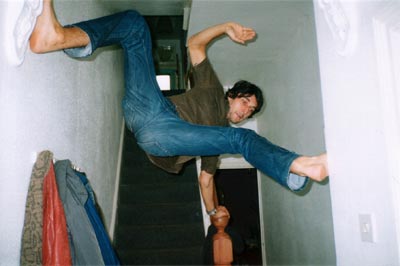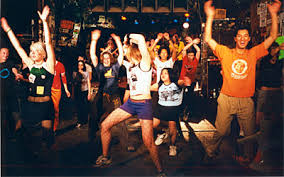|
A. INTEGRATIVE EXERCISE
When 58-year-old accountant John Willis travels to work on the underground, he gets off two stops early and walks the remaining distance at a brisk pace. Then, having arrived at his company's headquarters, he avoids the lift, taking the stairs instead to his office on the 8th floor. He does the same on the way home, covering an estimated total of two kilometres a day on foot: or as John is quick to point out, about 450 kilometres a year. 
He is doing what fitness experts have dubbed "integrative exercise", that is, incorporating physical activity into his normal daily life. It's a kill-two-birds-with-one-stone approach and can include anything from doing squats while loading the dishwasher to practicing yoga in the shower, or for those with a family, lifting children up during play sessions. There's no right or wrong way of doing it - each person has to work out their won strategy depending not the kind of life they lead.
So if you can't spare the time for the two-hour ordeal at the gym, this is the perfect solution, enabling you to fit regular workouts into a busy working week.
|
B. HOUSE GYMNASTICS
House Gymnastics, we are told, is a "crossbreed of yoga, bread-dancing, climbing and gymnastics enacted in a domestic setting". it is also great fun and a wonderful alternative to conventional forms of exercise. this short but delightful book with its charming tongue-in-cheek humor show how the home can be exploited in a variety of exciting new ways, becoming at once a playground, climbing frame and meeting place for fellow gymnasts. 
Simple graphics and easy-to-follow explanations talk the reader through the 25 core moves bearing names such as "armchair handstand", "ceiling walk" and "X-door". In no time at all you'll be crouching in fridges, propping yourself up in furniture, wedging yourself between walls and hanging from door frames. You can also play an active part in the development of the art form by creating your own moves and submitting them to the established website, www.housegymnastics.com.
Be warned though: House Gymnastics is not for the faint-hearted. the authors, Harrison and Ford, point out that "personal injury is a likely event" and the moves are not recommended for under-eighteens and over -84s.
|
|
C. PUNK ROCK AEROBICS
Tired of conventional gyms and the usual workouts, thirtysomethibng Boston punks Maura Jasper and Hilken Mancini decided to run their own aerobics classes, set to music by groups such as The Ramones, Buzzocks, Blondie, and The Undertones. The emphasis is firmly on fun, but the workouts are as through as they are light-hearted. "We want people to forget they are working out, even though they're working up a sweat", says artist Jasper, now also a certified aerobics instructor. 
In the same way that many punk songs were written with just three chords, so too there are just three lives for each song in a typical PRA routine. These have names like Iggy's Pop (raising one knee high and punching out with the opposite arm), Skank (marching in place) or Pogo (jumping up and down). If you can't afford weights, bricks can be used for strength training and a cheap piece of foam serves as a mat. Classes take place in darkly lit rock clubs and mirrors are intentionally missing to prevent participants feeling intimidated or self-conscious. There is also no dress code, though you are more likely to see people working out in denim shorts and fishnet stockings than leotards and leggings. Check out the website www.punckrockaerobics.com
|